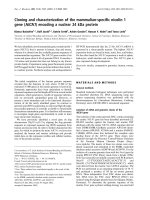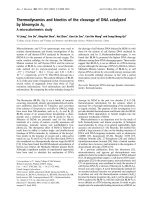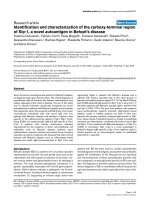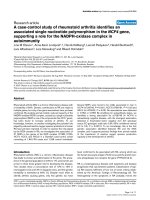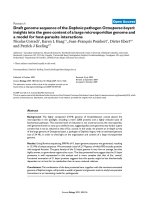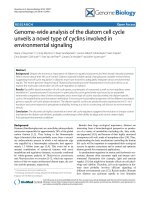Báo cáo y học: "A rare cause of forearm pain: anterior branch of the medial antebrachial cutaneous nerve injury: a case report" pdf
Bạn đang xem bản rút gọn của tài liệu. Xem và tải ngay bản đầy đủ của tài liệu tại đây (216.71 KB, 4 trang )
BioMed Central
Page 1 of 4
(page number not for citation purposes)
Journal of Brachial Plexus and
Peripheral Nerve Injury
Open Access
Case report
A rare cause of forearm pain: anterior branch of the medial
antebrachial cutaneous nerve injury: a case report
Necmettin Yildiz and Füsun Ardic*
Address: Department of Physical Medicine and Rehabilitation, Faculty of Medicine, Pamukkale University, Denizli, Turkey
Email: Necmettin Yildiz - ; Füsun Ardic* -
* Corresponding author
Abstract
Introduction: Medial antebrachial cutaneous nerve (MACN) neuropathy is reported to be caused
by iatrogenic reasons. Although the cases describing the posterior branch of MACN neuropathy
are abundant, only one case caused by lipoma has been found to describe the anterior branch of
MACN neuropathy in the literature. As for the reason for the forearm pain, we report the only
case describing isolated anterior branch of MACN neuropathy which has developed due to
repeated minor trauma.
Case presentation: We report a 37-year-old woman patient with pain in her medial forearm and
elbow following the shaking of a rug. Pain and symptoms of dysestesia in the distribution of the right
MACN were found. Electrophysiological examination confirmed the normality of the main nerve
trunks of the right upper limb and demonstrated abnormalities of the right MACN when compared
with the left side. Sensory action potential (SAP) amplitude on the right anterior branch of the
MACN was detected to be lower in proportion to the left. In the light of these findings, NSAI drug
and physical therapy was performed. Dysestesia and pain were relieved and no recurrence was
observed after a follow-up of 14 months.
Conclusion: MACN neuropathy should be taken into account for the differential diagnosis of the
patients with complaints of pain and dysestesia in medial forearm and anteromedial aspect of the
elbow.
Introduction
The medial antebrachial cutaneous nerve (MACN) arises
from the medial cord (78%) and the lower trunk (22%)
of the brachial plexus. It goes along the course of the
median and ulnar nerves, vena basilica, and arteria brachi-
alis, in the upper arm [1]. In the literature, causes of
MACN neuropathy include iatrogenic reasons such as
steroid injection due to medial epicondylitis, routine ven-
ipuncture, cubital tunnel surgery, loose body removal,
elbow arthroscopy, open fractures fixation, tumour exci-
sion, and arthrolysis [2-7]. It is also caused more rarely by
repeated minor trauma (from tennis) and soft tissue lacer-
ation. It is even more rarely brought about by tuberculoid
leprosy neuritis or subcutaneous lipoma [8-10]. However,
MACN neuropathy is thought to be noticed less often due
to the fact that it causes minor discomfort for the patients
and does not affect the hand [10]. Although in some cases
where MACN neuropathy was diagnosed, it was not spec-
ified which branch of the nerve was affected [3,7,9]. Due
to the variety in its anatomic localization, the posterior
Published: 21 April 2008
Journal of Brachial Plexus and Peripheral Nerve Injury 2008, 3:10 doi:10.1186/1749-7221-3-
10
Received: 20 November 2007
Accepted: 21 April 2008
This article is available from: />© 2008 Yildiz and Ardic; licensee BioMed Central Ltd.
This is an Open Access article distributed under the terms of the Creative Commons Attribution License ( />),
which permits unrestricted use, distribution, and reproduction in any medium, provided the original work is properly cited.
Journal of Brachial Plexus and Peripheral Nerve Injury 2008, 3:10 />Page 2 of 4
(page number not for citation purposes)
branch of MACN is inclined to be more vulnerable to
iatrogenic causes such as cubital tunnel surgery and direct
invasive procedures to the medial part of the elbow [2,4-
6,11]. Although the cases in the literature describing neu-
ropathy of the posterior branch of the MACN are abun-
dant [2,4-6] only one case caused by lipoma has been
found to describe the anterior branch of the MACN as the
site of neuropathy [10]. As for the reason for forearm pain,
we report the only case describing isolated neuropathy of
the anterior branch of the MACN which has developed
due to repeated minor trauma.
Case presentation
A 37-year-old woman patient who is a homemaker was
accepted to our hospital with the complaint of a 10-day
pain in her right upper limb. She mentioned that the pain
first involved the elbow and then the forearm, particularly
the medial part of it. Nearly 10 days before, while she was
cleaning and shaking the rug, she developed a discomfort-
ing pain in her right elbow. She explained that the pain in
her elbow had become worse and in 24 hours spread
through her whole forearm. She added that, previously,
the pain had been partially responding to NSAI drugs, but
subsequently, it continued to progressively increase.
There was a pain in her medial forearm and elbow. She
felt abnormal when she was palpated on her medial fore-
arm. During her examination, she was able to describe the
point where her pain started in the proximal part of her
elbow. On detailed neurological examination, a region of
dysesthesia which extends from the elbow to the medial
forearm was detected (Figure 1). The patient had no his-
tory of polyneuropathy, chronic systemic disease, injec-
tion or surgical intervention at the elbow. Range of
motion, motor, and reflex examinations of both upper
extremities were normal. Cervical spine examination was
normal. Varus-valgus stress test for the elbow was normal.
Medial epicondylitis test and tinel test for the ulnar nerve
were negative.
X-ray views of the elbow, including oblique views,
appeared normal. Electromyography showed normal
findings in the right biceps, triceps, flexor digitorum sub-
limis, pronator quadratus, interosseous and abductor pol-
licis brevis muscles, and nerve conduction studies in both
upper limbs except for the right MACN were found nor-
mal. The MACN is stimulated antidromically at the lateral
border of the biceps brachii tendon in the cubital fossa.
An active surface recording electrode is placed on the
anteromedial surface of the forearm 14 cm from the active
stimulating electrode. Sensory action potential (SAP)
amplitude of the right anterior branch of the MACN was
detected to be lower in proportion to the left. The sensory
conduction velocity (SCV) was normal. On both right and
left sides, the posterior branch of the MACN was normal
and symmetrical for amplitude and velocity (Table 1). On
magnetic resonance imaging of the elbow, no lesion was
detected which may cause MACN neuropathy.
As well as NSAI drug treatment, physical therapy of 15
days (TENS, ultrasound, ROM exercises) was applied to
the patient. The complaint of pain was totally relieved.
Two months later, the dysesthesia disappeared. No recur-
rence occured after a follow-up of 14 months.
Conclusion
Although isolated MACN neuropathy may be caused by
various iatrogenic reasons, it is described rarely by the rea-
sons of repeated minor trauma or soft tissue laceration
[6,8]. In the study by Stahl and Rosenberg, 12 patients
with MACN neuropathy were described. In two patients,
the reason for neuropathy was stated to be soft tissue lac-
eration but the shape and the cause of the injury was not
described [6]. Chang and Ho reported that MACN neu-
ropathy described in one of their cases was not isolated,
but was assosiated with lesion of the median nerve, and
that the reason for a second case with isolated MACN neu-
ropathy was repeated minor trauma [8]. In the literature,
the reason for the only case stating that the anterior
branch of the MACN was damaged was lipoma [10]. Our
case, however, is the only case describing isolated neurop-
athy of the anterior branch of the MACN which was devel-
oped by repeated minor trauma. Shaking a rug is a specific
method of cleaning the rug in which the elbows and wrist
will be used in repetitive flexion and extension. This activ-
ity requires forceful sustained contraction of the shoulder
girdle, upper arm, and forearm muscles to hold the rug
against the force of the weight of the rug and gravity.
Because of the superficial location of the nerve adjacent to
the biceps tendon, full extension of the elbow and repete-
The view of dysesthesic regionFigure 1
The view of dysesthesic region.
Publish with BioMed Central and every
scientist can read your work free of charge
"BioMed Central will be the most significant development for
disseminating the results of biomedical research in our lifetime."
Sir Paul Nurse, Cancer Research UK
Your research papers will be:
available free of charge to the entire biomedical community
peer reviewed and published immediately upon acceptance
cited in PubMed and archived on PubMed Central
yours — you keep the copyright
Submit your manuscript here:
/>BioMedcentral
Journal of Brachial Plexus and Peripheral Nerve Injury 2008, 3:10 />Page 3 of 4
(page number not for citation purposes)
tive forceful contracture of the flexor musculature may
place this nerve under stretch, effectively bowstringing it
across the elbow.
Both because it does not cause any limitation in the elbow
and it can not be detected by the radiologic MR imaging,
the neuroma is marginalized. Seror stated that the lesions
of MACN are rarely seen because we do not notice them
for several reasons such as isolated lesions of MACN not
affecting the hands, their causing only minor discomfort,
and the electrophysiological studies of MACNs not being
part of routine upper extremity electrodiagnostic exami-
nations [10]. Izzo et al. noted that in addition to the
median nerve sensory studies, the forearm sensory nerve
examinations can also be used to detect the situations of
peripheral neuropathy, brachial plexopathy and local
neuropathy [12]. MACN conduction studies were per-
formed by Seror in 70 control subjects to determine nor-
mal values and define the lower limits of normality. The
mean SAP amplitude was 17.5 μV, and the SCV was 61 m/
s. In the same study no SAP amplitude was lower than 6
μV [13]. With reference to the reported normal conduc-
tion values and the studies by Chang and Ho, and by
Seror, our case was diagnosed with right MACN neuropa-
thy due to the detections of normal SCV and lower SAP
amplitude of the right MACN [8,10,12,13] (Table 1).
Any surgical intervention, injection, trauma or forcing
activity of the elbow should be questioned and nerve neu-
ropathies should be considered, though they are rare, for
the complaints of forearm pain.
In conclusion, especially for the patients with complaints
of pain and dysesthesia in the medial forearm and anter-
omedial aspect of the elbow, MACN neuropathy should
be taken into account for the differential diagnosis and,
therefore, electrophysiologic examination should be per-
formed.
Competing interests
The authors declare that they have no competing interests.
Authors' contributions
NY and FA contributed equally to this case report. All
authors read and approved the final manuscript
Consent
Written informed consent was obtained from the patient
for publication of this case report and any accompanying
images.
References
1. Masear VR, Meyer RD, Pichora DR: Surgical anatomy of medial
antebrachial cutaneous nerve. J Hand Surg 1989, 14A:267-71.
2. Richards RR, Regan WD: Medial epicondylitis caused by injury
to the medial antebrachial cutaneous nerve: a case report.
Can J Surg 1989, 32(5):366-7.
3. Horowitz SH: Peripheral nerve injury and causalgia secondary
to routine venipuncture. Neurology 1994, 44:962-64.
4. Sarris I, Göbel F, Gainer M, Vardakas DG, Vogt MT, Sotereanos DG:
Medial brachial and antebrachial cutaneous nerve injuries:
Effect on outcome in revision cubital tunnel surgery. J Reconst
Microsurg 2002, 18(8):665-70.
5. Lowe JB, Maggi SP, Mackinnon SE: The position of crossing
branches of the medial antebrachial cutaneous nerve during
cubital tunnel surgery in humans. Plast Reconstr Surg 2004,
114:692-96.
6. Stahl S, Rosenberg N: Surgical treatment of painful neuroma in
medial antebrachial cutaneous nerve. Ann Plast Surg 2002,
48:154-60.
7. Kelly EW, Morrey BF, O'Driscoll SW: Complications of elbow
arthroscopy. J Bone Joint Surg Am 2001, 83-A(1):25-34.
8. Chang CW, Ho SJ: Medial antebrachial cutaneous neuropathy.
Case report. Electromyogr Clin Neurophysiol 1988, 28:3-5.
9. Martins RS, Siqueira MG, Carvalho AAS: A case of isolated tuber-
culoid leprosy of antebrachial medial cutaneous nerve. Neu-
rol Sci 2004, 25:216-19.
10. Seror P: Forearm pain secondary to compression of the
medial antebrachial cutaneous nerve at the elbow. Arch Phys
Med Rehabil 1993, 74(5):540-42.
Table 1: The nerve conduction data of the case.
RIGHT LEFT
MACN SCV (m/s) AMP (μV) SCV (m/s) AMP (μV)
Anterior Branch 57 2 56 9
Posterior Branch 56 10 58 11
MACN: Medial Antebrachial Cutaneous Nerve.
SCV: Sensory Conduction Velocity.
AMP: Sensory Action Potential (SAP) Amplitude.
Publish with BioMed Central and every
scientist can read your work free of charge
"BioMed Central will be the most significant development for
disseminating the results of biomedical research in our lifetime."
Sir Paul Nurse, Cancer Research UK
Your research papers will be:
available free of charge to the entire biomedical community
peer reviewed and published immediately upon acceptance
cited in PubMed and archived on PubMed Central
yours — you keep the copyright
Submit your manuscript here:
/>BioMedcentral
Journal of Brachial Plexus and Peripheral Nerve Injury 2008, 3:10 />Page 4 of 4
(page number not for citation purposes)
11. Dellon AL, Mackinnon SE: Injury to the medial antebrachial
cutaneous nerve during cubital tunnel surgery. J Hand Surg
1985, 10B(1):33-36.
12. Izzo KL, Aravabhumi S, Jafri A, Sobel E, Demopoulos JT: Medial and
lateral antebrachial cutaneous nerves: standardization of
technique, reliability and age effect on healty subjects. Arch
Phys Med Rehabil 1985, 66:592-97.
13. Seror P: The medial antebrachial cutaneous nerve: antidro-
mic and orthodromic conduction studies. Muscle Nerve 2002,
26:421-23.
